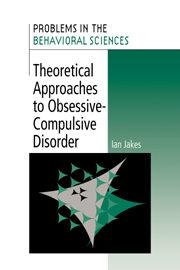Book contents
- Frontmatter
- Contents
- Dedication
- Synopsis of Theoretical approaches to obsessive-compulsive disorder
- Acknowledgments, and provenance of Theoretical approaches to obsessive-compulsive disorder
- 1 The natural history and definition of obsessive-compulsive disorder
- 2 Behavioural/learning accounts of OCD
- 3 Accounts of OCD based upon personality theories derived from the work of Pavlov
- 4 Janet on OCD
- 5 Psychodynamic approaches to OCD
- 6 Cognitive style/deficit approaches to OCD
- 7 Biological approaches to OCD
- 8 Concluding remarks
- References
- Author index
- Subject index
3 - Accounts of OCD based upon personality theories derived from the work of Pavlov
Published online by Cambridge University Press: 07 May 2010
- Frontmatter
- Contents
- Dedication
- Synopsis of Theoretical approaches to obsessive-compulsive disorder
- Acknowledgments, and provenance of Theoretical approaches to obsessive-compulsive disorder
- 1 The natural history and definition of obsessive-compulsive disorder
- 2 Behavioural/learning accounts of OCD
- 3 Accounts of OCD based upon personality theories derived from the work of Pavlov
- 4 Janet on OCD
- 5 Psychodynamic approaches to OCD
- 6 Cognitive style/deficit approaches to OCD
- 7 Biological approaches to OCD
- 8 Concluding remarks
- References
- Author index
- Subject index
Summary
Introduction
Numerous authors writing under the influence of Pavlov's (1928) seminal contribution have stressed the importance of individual differences in personality (or “temperament”) to the explanation of OCD and other dysthymic disorders (for example, neurotic depression, phobias, etc.). Most notable among these authors is Eysenck, through whose work (e.g., 1952, 1979) this personality theory approach is linked to the behavioural/learning account of OCD and phobias (see Chapter 2). A brief outline of this approach, along with some points of general relevance to it, will be followed by more detailed discussions of two recent contributions from this school – those of Gray (1982) and Claridge (1985) – and, in particular, the accounts these authors offer of OCD.
Eysenck's account, and suggested modifications of it
As discussed in Section 2.1, Eysenck considers OCD and phobias to result from the operation of conditioning mechanisms. Consistent with this, he holds that those people who are most inclined to develop conditioned responses (argued to be those who tend toward neurotic introversion) are those in whom these disorders are most likely to be observed.
Gray (1970) suggests, among other modifications of Eysenck's account, that it may only be in settings involving signals of “frustrative non-reward” or punishment that neurotic introverts are more inclined to develop conditioned responses.
Gray (1979, 1982) also denies, as does (to some extent) Claridge (1985), that it is the hypothesised greater inclination among neurotic introverts to develop conditioned responses that explains most cases of OCD and phobias.
- Type
- Chapter
- Information
- Theoretical Approaches to Obsessive-Compulsive Disorder , pp. 46 - 60Publisher: Cambridge University PressPrint publication year: 1996



